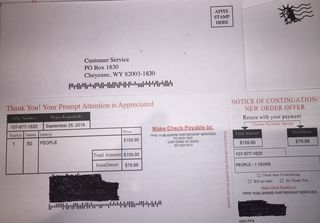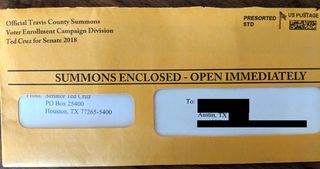Attention
Is This a Bill?
Why mail scams directed at senior citizens frequently succeed.
Posted September 21, 2018
She asked me simple questions. Is this a bill? Do I have to pay this? Really simple questions. But the answers can be confusing for many senior citizens, particularly those with cognitive declines. The problem is made worse by mailings targeted to confuse seniors.
For several years, I have helped an elderly relative pay her bills. I started simply to help with one problem: Determining if something was a real bill. This question isn’t as easy as it sounds. We all have bills arrive in the mail; whether they show up in snail-mail or email. We also frequently get other requests to send money. Some of those are from charities. Some are from political candidates. Others are from businesses trying to solicit new customers.
But many of these mailings are fundamentally dishonest. They pose as bills. A wolf hiding in a sleep’s clothing. These mailings are designed to look like bills. They often imply that you (or your elderly relative) already agreed to something, or that this is a continuation of an existing service. And that you owe money.
But distinguishing bill from fraud isn’t so easy. Consider these two examples.

The first is one that my elderly relative received. She has routinely received mailings from this company: PPS Publishers Partnership Services. The mailing looks like a bill. It has the words “Notice of Continuation” which is misleading at best, since my relative doesn’t have a subscription to that magazine. It directs where to send the check and requests “Prompt Attention.” It doesn’t look like the mailing is selling anything because there is no description of the magazine to be purchased or a clear statement of why someone would want the magazine. Instead this arrives looking like a bill that needs to be paid. This isn’t the only company that sends dishonest fake bills. I’ve used this since it is frequent and a well-known example (look up PPS Publishers Partnership Services on the internet). But my elderly relative receives lots of these, from lots of companies.

The second is a mailing that I saw online this week in Twitter. The envelope has a return address of “Official Travis County Summons, Voter Enrollment Campaign Division.” That certainly reads like a piece of mail about voting from the county government. In large font are the words “Summons Enclosed: Open Immediately.” Inside, according to the person who posted the mailer that was sent to his elderly relative, is a request for money for a Senator’s re-election campaign. The envelope does mention the senator, but that name is much less prominently displayed than the Summons. I wonder how much campaign money has been solicited from seniors by these types of mailings. I’ve seen many similar mailings addressed to my elderly relative that are intentionally designed to look like official government mailings – often looking like mailings from Medicare or Social Security. Most of these have been sent by various conservative political action committees. And yes, what I’ve seen from these types of political mailings have predominantly been from conservative groups aimed at senior citizens (I count things like that).
For me, and hopefully for you, a few moments is all it takes to recognize that these mailings are not bills and are not a government summons. The task is a straightforward perceptual discrimination task: Is this a bill? Is this a summons? How do you solve it? You have to remember if you owe those people money, if you agreed to buy something, if you recognize the real business. Tricky if the name on the mailing scam looks like a real thing. And these things are designed to look like the real thing. But with a bit of cognitive effort, you can remember, you can see it is not the real name, you can determine it is a scam. Hopefully, you can still remember what companies you already do business with. Generally, there are inconsistencies in the mailings. For example, the magazine being offered isn’t the same as the company to whom you should address the check. Similarly, there is usually a mix of statements and names that look official along with some other names to whom you should send money – inconsistencies in the content of the mailings. Hopefully, you can distinguish a fraud trying to disguise itself as an official government mailing. And when you recognize the fraud, the mail gets tossed in the recycling bin or deleted from the email inbox (and you don’t click on that link).
But if you’re busy, in a hurry, or distracted, you could be confused for a few moments. You might place this fake bill or fake summons in your business mail and not in your recycling bin. You might accidentally pay a fake bill and end up with a magazine subscription you didn’t really want. This is the reason so many people respond to email phishing. It looks legit, you click the button, and suddenly you’ve been hacked. Even if only a few people succumb, the profits can be large for the scammer.
And the task can be much more challenging for many senior citizens. Distinguishing a real bill from a scam gets harder when someone is suffering even the mildest of cognitive declines. They may not be able to remember if they ordered something. They may not know if they have already done business with the company or if they have previously subscribed to the magazine. They may have challenges determining if the business is real or fake. They may not be able to track the internal inconsistencies. Thus, the mail scammers target the elderly. I imagine the hit rate is higher among the elderly than among other adults.
I don’t have a simple solution for this. But if you have an elderly relative, I might suggest starting to look at their mail with them. Make sure they are still successfully tossing these scams into the recycling bin. I think susceptibility to these types of scams is an early indicator of cognitive declines. Even before declines show up on the basic measures of dementia, people will experience challenges sorting and responding to their mail. This will happen to both their snail-mail and their email.
You should also pay attention to the emails you receive from elderly relatives. If your relative has frequently sent you weird emails, this probably indicates that they’ve clicked on some link in a scam email. In perusing my relative’s email recently, almost all of her email was from other seniors who had been hacked by clicking on a link in their emails. A vicious spiral of email hacks circulating among seniors. A sign of difficulty tracking what is a real message and what is a worm on a hook phishing for access to someone’s email account or computer.
If you are concerned, you should start by simply sorting snail-mail and email with your relative. This will help your loved one avoid being scammed. This is the solution I recommend trying.
There is, of course, another solution, and it involves requiring honesty in mailings. Good luck with that. In the meantime, be vigilant, for yourself and your relatives.




